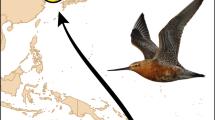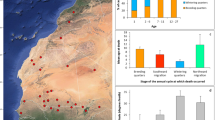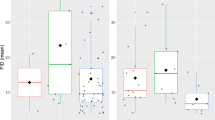Abstract
Each year, billions of flying and swimming migrants negotiate the challenging displacement imposed by travelling through a flowing medium. However, little is known about how the ability to cope with drift improves through life and what mechanisms drive its development. We examined 3,140 days of migration by 90 GPS-tagged raptorial black kites (Milvus migrans) aged 1–27 years to show that the ability to compensate for lateral drift develops gradually through many more years than previously appreciated. Drift negotiation was under strong selective pressure, with inferior navigators subject to increased mortality. This progressively selected for adults able to compensate for current cross flows and for previously accumulated drift in a flexible, context-dependent and risk-dependent manner. Displacements accumulated en route carried over to shape the wintering distribution of the population. For many migrants, migratory journeys by younger individuals represent concentrated episodes of trait selection that shape adult populations and mediate their adaptation to climate change.
This is a preview of subscription content, access via your institution
Access options
Access Nature and 54 other Nature Portfolio journals
Get Nature+, our best-value online-access subscription
$29.99 / 30 days
cancel any time
Subscribe to this journal
Receive 12 digital issues and online access to articles
$119.00 per year
only $9.92 per issue
Buy this article
- Purchase on Springer Link
- Instant access to full article PDF
Prices may be subject to local taxes which are calculated during checkout




Similar content being viewed by others
Data availability
Data are available from DIGITAL.CSIC at https://doi.org/10.20350/digitalCSIC/14652.
References
Newton, I. The Migration Ecology of Birds (Academic Press, 2008).
Dingle, H. Migration: The Biology of Life on the Move (Oxford Univ. Press, 1996).
Chapman, J. W. et al. Animal orientation strategies for movement in flows. Curr. Biol. 21, R861–R870 (2011).
Alerstam, T. Wind as a selective agent in bird migration. Ornis Scand. 10, 76–93 (1979).
Berthold, P. Bird Migration: A General Survey (Oxford Univ. Press, 2001).
Alerstam, T. & Lindstrom, A. in Bird Migration: Physiology and Ecophysiology (ed. Gwinner, E.) 331–351 (Springer, 1990).
Chapman, J. W. et al. Wind selection and drift compensation optimize migratory pathways in a high-flying moth. Curr. Biol. 18, 514–518 (2008).
Hays, G. C. et al. Route optimisation and solving Zermelo’s navigation problem during long distance migration in cross flows. Ecol. Lett. 17, 137–143 (2014).
Chapman, J. W. et al. Adaptive strategies in nocturnally migrating insects and songbirds: contrasting responses to wind. J. Anim. Ecol. 85, 115–124 (2016).
Alerstam, T. Optimal bird migration revisited. J. Ornithol. 152, 5–23 (2011).
Alerstam, T. & Hedenström, A. The development of bird migration theory. J. Avian Biol. 29, 343–369 (1998).
Shamoun, J., Felix, B. & Wouter, L. Atmospheric conditions create freeways, detours and tailbacks for migrating birds. J. Comp. Physiol. A 203, 509–529 (2017).
Liechti, F. Birds: Blowin’ by the wind? J. Ornithol. 147, 202–211 (2006).
Thorup, K., Alerstam, T., Hake, M. & Kjellén, N. Bird orientation: compensation for wind drift in migrating raptors is age dependent. Proc. R. Soc. B 270, 8–11 (2003).
Sergio, F. et al. Migration by breeders and floaters of a long-lived raptor: implications for recruitment and territory quality. Anim. Behav. 131, 59–72 (2017).
Sergio, F. et al. Individual improvements and selective mortality shape lifelong migratory performance. Nature 515, 410–413 (2014).
Sergio, F., Blas, J. & Hiraldo, F. Predictors of floater status in a long-lived bird: a cross-sectional and longitudinal test of hypotheses. J. Anim. Ecol. 78, 109–118 (2009).
Bildstein, K. L. Migrating Raptors of the World: Their Ecology and Conservation (Cornell Univ. Press, 2006).
Zalles, J. I. & Bildstein, K. L. Raptor Watch: A Global Directory of Raptor Migration Sites (Birdlife International, 2000).
Kerlinger, P. Flight Strategies of Migrating Hawks (University of Chicago Press, 1989).
Sergio, F. et al. When and where mortality occurs throughout the annual cycle changes with age in a migratory bird: individual vs population implications. Sci. Rep. 9, 17352 (2019).
Sergio, F. et al. Raptor nest decorations are a reliable threat against conspecifics. Science 331, 327–330 (2011).
Parker, D. & Diop-Kane, M. Meteorology of Tropical West Africa: The Forecaster’s Handbook (2017).
Liechti, F., Hedenström, A. & Alerstam, T. Effects of sidewinds on optimal flight speed of birds. J. Theor. Biol. 170, 219–225 (1994).
Liechti, F. & Bruderer, B. The relevance of wind for optimal migration theory. J. Avian Biol. 29, 561–568 (1998).
Cresswell, W. Migratory connectivity of Palaearctic–African migratory birds and their responses to environmental change: the serial residency hypothesis. Ibis 156, 493–510 (2014).
Alerstam, T., Hedenström, A. & Åkesson, S. Long-distance migration: evolution and determinants. Oikos 103, 247–260 (2003).
Bowlin, M. S. et al. Grand challenges in migration biology. Integr. Comp. Biol. 50, 261–279 (2010).
Mitchell, G. W., Woodworth, B. K., Taylor, P. D. & Norris, D. R. Automated telemetry reveals age specific differences in flight duration and speed are driven by wind conditions in a migratory songbird. Mov. Ecol. https://doi.org/10.1186/s40462-015-0046-5 (2015).
Rotics, S. et al. The challenges of the first migration: movement and behaviour of juvenile vs. adult white storks with insights regarding juvenile mortality. J. Anim. Ecol. 85, 938–947 (2016).
Horvitz, N. et al. The gliding speed of migrating birds: slow and safe or fast and risky? Ecol. Lett. 17, 670–679 (2014).
Reichler, T. Changes in the Atmospheric Circulation as Indicator of Climate Change (Elsevier, 2009).
Kling, M. M. & Ackerly, D. D. Global wind patterns and the vulnerability of wind-dispersed species to climate change. Nat. Clim. Change 10, 868–875 (2020).
Drake, A., Rock, C. A., Quinlan, S. P., Martin, M. & Green, D. J. Wind speed during migration influences the survival, timing of breeding, and productivity of a neotropical migrant, Setophaga petechia. PLoS ONE 9, e97152 (2014).
Newton, I. Can conditions experienced during migration limit the population levels of birds? J. Ornithol. 147, 146–166 (2006).
Loonstra, A. H. J., Verhoeven, M. A., Senner, N. R., Both, C. & Piersma, T. Adverse wind conditions during northward Sahara crossings increase the in-flight mortality of black-tailed godwits. Ecol. Lett. 22, 2060–2066 (2019).
Blas, J., Sergio, F. & Hiraldo, F. Age-related improvement in reproductive performance in a long-lived raptor: a cross-sectional and longitudinal study. Ecography 32, 647–657 (2009).
Sergio, F. et al. No effect of satellite tagging on survival, recruitment, longevity, productivity and social dominance of a raptor, and the provisioning and condition of its offspring. J. Appl. Ecol. 52, 1665–1675 (2015).
Kenward, R. A Manual for Wildlife Radio Tagging (Academic Press, 2001).
Hersbach, H., et al. ERA5 hourly data on pressure levels from 1979 to present. Copernicus Climate Change Service Climate Data Store https://doi.org/10.24381/cds.bd0915c6 (2018).
Klaassen, R. H. G., Hake, M., Strandberg, R. & Alerstam, T. Geographical and temporal flexibility in the response to crosswinds by migrating raptors. Proc. R. Soc. B 278, 1339–1346 (2011).
Bohrer, G. et al. Estimating updraft velocity components over large spatial scales: contrasting migration strategies of golden eagles and turkey vultures. Ecol. Lett. 15, 96–103 (2012).
Shannon, H. D., Young, G. S., Yates, M. A., Fuller, M. R. & Seegar, W. S. Measurements of thermal updraft intensity over complex terrain using American white pelicans and a simple boundary-layer forecast model. Bound. Layer Meteorol. 104, 167–199 (2002).
Stull, R. B. An Introduction to Boundary Layer Meteorology (Springer, 1988).
Safi, K. et al. Flying with the wind: scale dependency of speed and direction measurements in modelling wind support in avian flight. Mov. Ecol. 1, 1–13 (2013).
Batschelet, E. Circular Statistics in Biology (Academic Press, 1981).
R Core Team. R: A Language and Environment for Statistical Computing (R Foundation for Statistical Computing, 2019).
O’Neill, P. Magnetoreception and baroreception in birds. Dev. Growth Differ. 55, 188–197 (2013).
Bingman, V.P. and Moore, P. in Aeroecology (eds. Chilson, P. B. et al.) 119–143 (Springer International Publishing, 2017).
Liechti, F. and McGuire, L. P. in Aeroecology (eds. Chilson, P. B. et al.) 179–198 (Springer International Publishing, 2017).
Richardson, W. J. Wind and orientation of migrating birds: a review. EXS 60, 226–249 (1991).
Pettorelli, N. et al. Using the satellite-derived NDVI to assess ecological responses to environmental change. Trends Ecol. Evol. 20, 503–510 (2005).
Dodge, S. et al. Environmental drivers of variability in the movement ecology of turkey vultures (Cathartes aura) in North and South America. Philos. Trans. R. Soc. B 369, 20130195 (2014).
Schaub, M., Kania, W. & Köppen, U. Variation of primary production during winter induces synchrony in survival rates in migratory white storks Ciconia ciconia. J. Anim. Ecol. 74, 656–666 (2005).
Despland, E., Rosenberg, J. & Simpson, S. J. Landscape structure and locust swarming: a satellite’s eye view. Ecography 27, 381–391 (2004).
Trierweiler, C. et al. A Palaearctic migratory raptor species tracks shifting prey availability within its wintering range in the Sahel. J. Anim. Ecol. 82, 107–120 (2013).
Zuur, A. F., Ieno, E. N., Walker, N. J., Saveliev, A. A. & Smith, G. M. Mixed Effects Models and Extensions in Ecology with R (Springer, 2009).
Sapir, N., Horvitz, N., Dechmann, D. K. N., Fahr, J. & Wikelski, M. Commuting fruit bats beneficially modulate their flight in relation to wind. Proc. R. Soc. B 281, 20140018 (2014).
Becciu, P., Panuccio, M., Catoni, C., Dell'omo, G. & Sapir, N. Contrasting aspects of tailwinds and asymmetrical response to crosswinds in soaring migrants. Behav. Ecol. Sociobiol. 72, 28 (2018).
Klaassen, R. H. G. et al. Loop migration in adult marsh harriers Circus aeruginosus, as revealed by satellite telemetry. J. Avian Biol. 41, 200–207 (2010).
Strandberg, R., Klaassen, R. H. G., Hake, M. & Alerstam, T. How hazardous is the Sahara Desert crossing for migratory birds? Indications from satellite tracking of raptors. Biol. Lett. 6, 297–300 (2010).
Pennycuick, D. J. Modelling the Flying Bird (Academic Press, 2008).
Shepard, E. L. C., Ross, A. N. & Portugal, S. J. Moving in a moving medium: new perspectives on flight. Phil. Trans. R. Soc. B 371, 20150382 (2016).
Van Doren, B. M., Horton, K. G., Stepanian, P. M., Mizrahi, D. S. & Farnsworth, A. Wind drift explains the reoriented morning flights of songbirds. Behav. Ecol. 27, 1122–1131 (2016).
Sergio, F., Tanferna, A., Blas, J., Blanco, G. & Hiraldo, F. Reliable methods for identifying animal deaths in GPS- and satellite-tracking data: review, testing, and calibration. J. Appl. Ecol. 56, 562–572 (2019).
Crawley, M. J. The R Book (Wiley, 2013).
Nakagawa, S. & Schielzeth, H. A general and simple method for obtaining R2 from generalized linear mixed-effects models. Methods Ecol. Evol. 4, 133–142 (2013).
Acknowledgements
We thank F.J. Chicano, F.G. Vilches, J.M. Giralt and M. Anjos for help in the field, I. Afán and D. Aragonés of LAST–EBD for support with GIS analyses, the personnel of the Reserva Biológica de Doñana–ICTS for logistical help and accommodation, E. Palazuelos for preparing Supplementary Video 1 and F.J. Hernández for the kite drawing in Fig. 1. Part of the study was funded by Natural Research Ltd. and research projects CGL2008-01781 (F.S.), CGL2011-28103 (F.S.), CGL2012-32544 (J.B.) and PGC2018-095860-B-I00 (F.S.) of the Spanish Ministry of Science and Innovation/Economy and Competitiveness and FEDER funds; 511/2012 (J.B.) of the Spanish Ministry of Agriculture, Food and the Environment (Autonomous Organism of National Parks); JA-58 (F.S.) of the Consejería de Medio Ambiente de la Junta de Andalucía and by the Excellence Projects RNM 1790 (F.S.), RNM 3822 (F.S.), RNM 7307 (F.S.) and P18-FR-4239 (F.S.) of the Junta de Andalucía. J.M.B was supported by Generalitat Valenciana (CIDEGENT/2020/030).
Author information
Authors and Affiliations
Contributions
F.S., A.T., J.B. and F.H. conducted fieldwork. F.S., A.T. and J.M.B. prepared the database, extracted and processed the environmental data from internet sources and analysed the data. F.S., J.B. and F.H. obtained funding. F.S., J.M.B, A.T., R.S., J.B. and F.H. took part in the conceptual planning of the study and in the preparation of the manuscript.
Corresponding author
Ethics declarations
Competing interests
The authors declare no competing interests.
Peer review
Peer review information
Nature Ecology & Evolution thanks Jason Chapman, Will Cresswell and two other, anonymous, reviewers for their contribution to the peer review of this work.
Additional information
Publisher’s note Springer Nature remains neutral with regard to jurisdictional claims in published maps and institutional affiliations.
Supplementary information
Supplementary Information
Supplementary Figs. 1–7 and Tables 1–6.
Supplementary Video 1.
Flow negotiation strategies by migrants. Conceptual representation of crosswind negotiation strategies by migrating raptors; by orienting their heading progressively more towards a lateral crosswind, migrants can compensate progressively more for the drift imposed by the side flow. The outcome of such orientation strategies can range from full drift to partial compensation or full compensation.
Rights and permissions
About this article
Cite this article
Sergio, F., Barbosa, J.M., Tanferna, A. et al. Compensation for wind drift during raptor migration improves with age through mortality selection. Nat Ecol Evol 6, 989–997 (2022). https://doi.org/10.1038/s41559-022-01776-1
Received:
Accepted:
Published:
Issue Date:
DOI: https://doi.org/10.1038/s41559-022-01776-1



